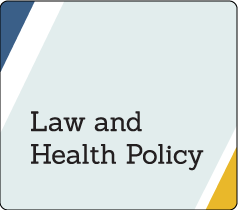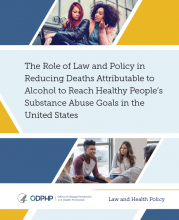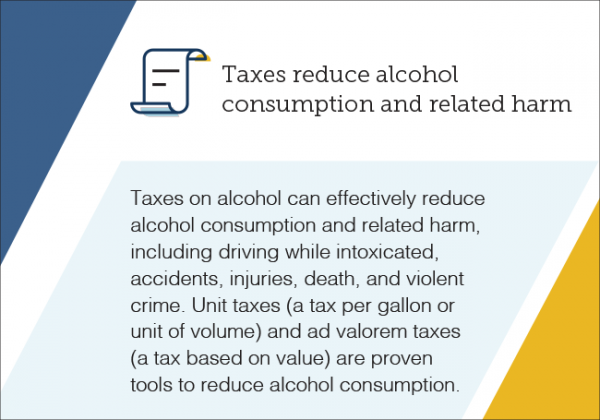This content was part of the Healthy People 2020 Law and Health Policy project, which ended in 2020.
Using Law and Policy to Reduce Alcohol-Related Deaths in the United States
Alcohol use is common, costly, and dangerous. In 2019, about 70% of American adults reported consuming alcohol in the past 12 months.1 In the United States, excessive alcohol use cost an estimated $249 billion in 2010.2 And nearly 90,000 people in this country die each year from alcohol-related causes, making it one of the leading causes of death and injury.3
Congress has the authority to import and tax alcohol, but the 21st Amendment gives states most of the authority to enact laws and policies governing the manufacturing, sale, and possession of alcohol. Laws and policies can help support healthier, safer, and more livable communities and reduce the negative effects of alcohol use — including many state-level policy solutions.
This is a summary of the report, The Role of Law and Policy in Reducing Deaths Attributable to Alcohol to Reach Healthy People’s Substance Abuse Goals in the United States, which was the fourth in a series of reports that highlighted the practical application of law and policy to improve health across the nation. Each report also had success stories, or Bright Spots, that illustrated how communities had used law and policy to meet their health goals and achieve Healthy People targets.
This report presented evidence-based policy solutions that community and tribal leaders, government officials, public health professionals, health care providers, lawyers, and social service providers could use in their own communities to meet Healthy People 2020 Substance Abuse objectives — including the objective focused on reducing alcohol-related deaths.
Download Fact Sheet [PDF - 981 KB]
Key Finding: Policy interventions can affect alcohol consumption patterns by limiting alcohol availability
- The National Minimum Legal Drinking Age Act of 1984 is an example of a successful intervention to limit the legal availability of alcohol. In an effort to limit youth access to alcohol, the federal government pressured states to raise their drinking ages from age 18 to 21. States that didn’t comply would lose federal highway construction funds. By 1988, every state raised its drinking age to age 21—a change that’s associated with fewer traffic crash deaths, homicides, suicides, and unintentional injuries nationwide.4,5,6
- High concentrations of retail alcohol outlets can result in increased excessive drinking.7 Policies that reduce the density of alcohol retail outlets can reduce alcohol-related harms. This includes policies that limit the number of liquor licenses issued per population and zoning ordinances that limit where outlets can be located.
- Government-controlled alcohol wholesale and retail systems have fewer stores and sell alcohol for fewer hours each day compared to privately-run systems. States with alcohol retail control have lower rates of sales to minors, less underage use, and fewer alcohol-impaired deaths in youth.8
- Policies that increase the price of alcohol, including policies that regulate pricing and taxes, also result in fewer alcohol-related harms. Increasing taxes is one of the most effective ways to make alcohol less accessible and reduce related harms—including alcohol-impaired driving, cirrhosis mortality rates, and alcohol-related mortality rates.9,10
Featured Graphic: Map of Control State Jurisdiction
Key Finding: Policy interventions, such as blood alcohol content (BAC) restrictions and ignition interlock laws, can reduce rates of alcohol-impaired driving fatalities
- In 2000, U.S. Department of Transportation’s (DOT) Appropriations Act required states to enact a law that sets a BAC limit for drivers of no more than 0.08 to avoid losing federal highway construction funds. Enforcing this policy has resulted in fewer impaired drivers—and fewer alcohol-related crashes and fatalities.11
- In 2018, Utah became the first state to reduce their legal BAC to 0.05 mg/dl in an effort to decrease crashes and fatalities. Since 1995, Maine has prohibited individuals who were previously convicted of impaired driving from having any measurable BAC while driving. Reducing the legal BAC also decreases deaths in individuals who aren’t heavy alcohol users.12
- Ignition interlocks can be used to prevent people from driving with a BAC at or above a set threshold. Currently, 28 states require ignition interlocks in vehicles for people who have been convicted of impaired driving. These policies are effective in reducing re-arrest laws and alcohol-related fatal crashes.13 Increasing the number of states with mandatory ignition interlock policies is one of Healthy People 2020’s Substance Abuse objectives.
- In 2013, the National Highway Traffic Safety Administration (NHTSA) developed “Model Guidelines for State Ignition Interlock Programs.” States can use these guidelines to strengthen their ignition interlock programs.
Key Finding: Policy interventions at all levels can help counteract emerging issues that affect excessive alcohol consumption in the United States
- Several emerging issues may affect alcohol consumption across the country. As the alcohol industry continues to evolve, policy-makers must develop innovative solutions to reduce alcohol-related harms and deaths.
- Policies to address new products that are especially attractive to youth—like powdered alcohol—can help reduce alcohol consumption. For example, several states have addressed powdered alcohol by either banning its sale or expanding the definition of alcohol in existing laws to include powdered alcohol.
- Nearly 50 million people got health insurance when the Affordable Care Act was implemented in 2014. Previously, about 1 in 3 insurance plans didn’t cover mental health and substance abuse services. This federal policy increased access to substance abuse care and treatment for millions of people in the United States.
- Alcohol-impaired driving policies should be updated when needed to combat other forms of impaired driving—such as driving under the influence of marijuana or prescription drugs. For example, several states have developed policies that train police as phlebotomists so they can draw blood from suspected impaired drivers on site to test for substances.
- States must continue to develop innovative, effective policy solutions to reduce alcohol-related harms—including interventions to keep alcohol-involved offenders from repeating their offenses. For example, South Dakota’s 24/7 Sobriety Program requires participants to avoid using alcohol and participate in sobriety tests 2 times a day. This helps reduce crime while keeping offenders in the community.
Key Finding: Additional research is critical to the implementation and enforcement of alcohol policy interventions
- Engaging in research on the effectiveness of individual alcohol policies as well as how different policies work together has led to a strong body of alcohol policy research.
- Although alcohol policy literature has grown significantly in the past few decades, more research is needed—specifically research to identify the most efficient and effective law and policy interventions.
- Data systems like the Alcohol Policy Information System, Prescription Drug Abuse Policy System, and LawAtlas provide useful information that researchers and policy-makers can use to understand the effects of policy decisions on health outcomes.
Conclusion
The Healthy People 2020 objectives related to substance abuse—specifically alcohol use—are ambitious but attainable. To meet these targets, federal, tribal, state, and local communities and organizations should leverage existing laws and policies—and use data collection and research to inform future laws and policies.
To help the Nation meet these objectives, it is important to:
- Engage in interventions to promote population-level change in alcohol availability and reduce alcohol-related harms
- Use laws and policies to promote safe driving and reduce the rates of alcohol-impaired driving fatalities
- Develop or update policies to address emerging issues affecting alcohol consumption in the United States—and continue to monitor new issues as they develop
- Conduct additional research to better understand the effectiveness of specific individual policies as well as combinations of different policies on alcohol-related harms
Taking these steps will help ensure that people live in communities that work to prevent alcohol-related harms.
Related Healthy People 2020 Objectives
- IVP-2: Reduce fatal and nonfatal traumatic brain injuries
- SA-5: (Developmental) Increase the number of drug, driving while impaired (DWI), and other specialty courts in the United States
- SA-6: Increase the number of States with mandatory ignition interlock laws for first and repeat impaired driving offenders in the United States
- SA-11: Reduce cirrhosis deaths
- SA-14: Reduce the proportion of persons engaging in binge drinking of alcoholic beverages
- SA-15: Reduce the proportion of adults who drank excessively in the previous 30 days
- SA-16: Reduce average annual alcohol consumption
- SA-17: Decrease the rate of alcohol-impaired driving (.08+ blood alcohol content [BAC]) fatalities
- SA-20: Reduce the number of deaths attributable to alcohol
1. U.S. Department of Health and Human Services, National Institute of Alcohol Abuse and Alcoholism. Alcohol facts and statistics [Internet]. Bethesda (MD): updated 2019 Aug, cited 2019 Sept 30. Available from: https://www.niaaa.nih.gov/alcohol-facts-and-statistics.
2. Sacks JJ, Gonzales KR, Bouchery EE, Tomedi LE, Brewer RD. 2010 National and state costs of excessive alcohol consumption. Am J Prev Med. 2015; 49(5): e73-e79.
3. U.S. Department of Health and Human Services, Centers for Disease Control and Prevention. Alcohol-related disease impact [Internet]. Atlanta (GA): cited 2016 Oct 3. Available from: https://nccd.cdc.gov/DPH_ARDI/default/default.aspx.
4. McCartt AT, Hellinga LA, Kirley BB. The effects of minimum legal drinking age 21 laws on alcohol-related driving in the United States. J Safety Research. 2010 Apr;41(2), 173-181.
5. Parker RN, Rebhun LA. Alcohol and homicide: A deadly combination of two American traditions. Albany (NY): State Univ. of New York Press; 1995; 187.
6. Birckmayer J, Hemenway D. Minimum-age drinking laws and youth suicide, 1970–1990. Am J Public Health. 1999; 89(9):1365–1368.
7. U.S. Department of Health and Human Services, Centers for Disease Control and Prevention. Guide for measuring alcohol outlet density [Internet.] Atlanta (GA): 2017, Reviewed 2017 Aug 3, pg. 55 cited 2018 Mar 11. Available from: https://www.cdc.gov/alcohol/pdfs/CDC-Guide-for-Measuring-Alcohol-Outlet-Density.pdf.
8. Miller T, Snowden C, Birckmayer J, Hendrie D. Retail alcohol monopolies, underage drinking, and youth impaired driving deaths. Accid Anal Prev. 2006; 38(6):1162-1167.
9. Lavoie M-C, Langenberg P, Villaveces A, Dischinger PC, Simoni-Wastila L, Hoke K, et al. Effect of Maryland’s 2011 alcohol sales tax increase on alcohol-positive driving. Am J Prev Med. 2017; 53(1):17–24.
10. Cook PJ. The impact of distilled-spirits taxes on consumption, auto fatalities, and cirrhosis mortality. In: Holder HD, editor. Control issues in alcohol abuse prevention: strategies for states and communities. Greenwich (CT): JAI Press Inc; p 159-167.
11. Scherer M, Fell JC. Effectiveness of lowering the blood alcohol concentration (BAC) limit for driving from 0.10 to 0.08 grams per deciliter in the United States. Traffic Injury Prev. 2019 Jan 2; 20(1):1-8.
12. Jones and Rodriguez-Iglesias. Evaluation of lower BAC limits for convicted OUI offenders in Maine. Washington (DC): U.S. Department of Transportation, National Highway Traffic Safety Administration; 2004. Report No.: DOT HS 809827.
13. Elder RW, Voas R, Beirness D, Shults RA, Sleet DA, Nichols JL, Compton R; Task Force on Community Preventive Services. Effectiveness of ignition interlocks for preventing alcohol-impaired driving and alcohol-related crashes: a Community Guide systematic review. Am J Prev Med. 2011; 40(3):362–76.



